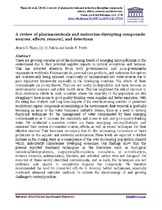| dc.contributor.author | Tijani, Jimoh O. | |
| dc.contributor.author | Fatoba, Ojo O. | |
| dc.contributor.author | Petrik, Leslie | |
| dc.date.accessioned | 2018-02-06T10:24:55Z | |
| dc.date.available | 2018-02-06T10:24:55Z | |
| dc.date.issued | 2013 | |
| dc.identifier.citation | Tijani, J.O. et al. (2013). A review of pharmaceuticals and endocrine-disrupting compounds: sources, effects, removal, and detections. Water, Air & Soil Pollution, 224: 1770 | en_US |
| dc.identifier.issn | 0049-6979 | |
| dc.identifier.uri | http://dx.doi.org/10.1007/s.11270-013-1770-3 | |
| dc.identifier.uri | http://hdl.handle.net/10566/3474 | |
| dc.description.abstract | There are growing concerns about the increasing trends of emerging micropollutants in the environment due to their potential negative impacts on natural ecosystems and humans. This has attracted attention from both governmental and non-governmental organisations worldwide. Pharmaceuticals, personal care products, and endocrine disruptors are continuously being released consciously or unconsciously into water sources due to poor regulatory frameworks especially in the developing countries. The effects of these contaminants are poorly known. They are not easily biodegradable and have become an environmental nuisance and public health issue. This has heightened the risk of exposure to their deleterious effects in such countries where the majority of the population are still struggling to have access to good quality drinking water supplies and better sanitation. With the rising fear of short- and long-term impacts of the ever-increasing number of persistent recalcitrant organic compounds accumulating in the environment, their removal is gradually becoming an issue to the water treatment industry. Hence, there is a need to develop functional techniques for the management of water contaminated by these emerging contaminants so as to increase the availability and access to safe and good-quality drinking water. We conducted a narrative review on these emerging micropollutants and examined their various documented sources, effects, as well as recent techniques for their effective removal. This becomes necessary due to the increasing occurrence of these pollutants in the aquatic and terrestrial environment. These levels are expected to further increase in the coming years as a consequence of the ever-increasing population density which undoubtedly characterizes developing economies. Our findings show that the present reported treatment techniques in the literature such as biological oxidation/biodegradation, coagulation/flocculation, ozonation, el ectrodialysis, reverse osmosis, sedimentation, filtration, and activated carbon were not designed for removal of these newly identified contaminants, and as such, the techniques are not sufficient and unable to completely degrade the compounds. We therefore recommended the need for concerted efforts to develop better techniques, especially combined advanced oxidative methods to address the shortcomings of and growing challenge to current practices. | en_US |
| dc.language.iso | en | en_US |
| dc.publisher | Springer | en_US |
| dc.rights | This is the author-version of the article published online at: http://dx.doi.org/10.1007/s.11270-013-1770-3 | |
| dc.subject | Pharmaceutical and personal care products | en_US |
| dc.subject | Endocrine disrupting compounds | en_US |
| dc.subject | Coagulation/ flocculation | en_US |
| dc.subject | Ozonation | en_US |
| dc.subject | Electrodialysis | en_US |
| dc.subject | Reverse osmosis | en_US |
| dc.subject | Sedimentation | en_US |
| dc.subject | Filtration | en_US |
| dc.subject | Activated carbon | en_US |
| dc.subject | Advanced oxidation process | en_US |
| dc.title | A review of pharmaceuticals and endocrine-disrupting compounds: sources, effects, removal, and detections | en_US |
| dc.type | Article | en_US |
| dc.privacy.showsubmitter | FALSE | |
| dc.status.ispeerreviewed | TRUE | |
| dc.description.accreditation | Web of Science | |

